


|
Joined:
|
28/01/2011 |
|---|---|
|
Last Updated:
|
28/01/2011 |
|
Location:
|
Gjøvik, Norway |
|
Climate Zone:
|
Cold Temperate |
|
Gender:
|
Male |
|
Web site:
|
permaliv.blogspot.com/ |
(projects i'm involved in)
(projects i'm following)
Back to Øyvind Holmstad's profile
Posted by Øyvind Holmstad over 13 years ago
Norway is said to be a social democratic country, which means a 50 – 50 percent mixture of socialism and capitalism. The catch is that in the end there is no difference between these two ideologies. It is like mixing water with water — no matter how well you blend them, or in what ratio, the finished product is modernism. A separation of function (and people) is one of, or maybe even the most important dogma of, modernism, with devastating consequences for human life. This separation was common in the former USSR, and is common in today’s USA.
Here we can see the radical nature of Berry’s vision. Our entire economy, our very culture of work, leisure, and home is constructed around the idea of easy mobility and the disintegration of various aspects of our lives. We live in one place, work in another, shop in another, worship in another, and take our leisure somewhere else. According to Berry, an integrated life, a life of integrity, is one characterized by membership in a community in which one lives, works, worships, and conducts the vast majority of other human activities. The choice is stark: “If we do not live where we work, and when we work, we are wasting our lives, and our work too.” - Wendell Berry and the New Urbanism: Agrarian Remedies, Urban Prospects
The artificial separation of houses and work creates intolerable rifts in people’s inner lives. - Christopher Alexander
Further this separation of function creates a segregation of generations. Today there’s a discussion in my country whether the state or a private company is best suited for taking care of elderly people. But what does it matter if you are institutionalized by a private or an official institution? Something has gone wrong in a society which sees institutionalising its citizens as a necessity or goal; this is a sign of a failed design. In a more intricate, complex design, there will be room for everyone. This is because the network of patterns is so finely woven that hardly anybody can fall through it and get hurt.
A village town has a wall around it — to strengthen its identity, but also for protection. The protection is not against enemies, but for people to orient themselves. Combine this with a system based on face to face interaction which encourages people to take care of each other, and viola, institutions are hardly needed. Those few left should have the goal of securing people from becoming institutionalized.
We’re also recognizing that living in community is literally good for us. Scientific research show that our health improves when we live in a web of connection with others. “Of all the many influences on our health, interpersonal relationships are not only a factor, but increasingly are being recognized as the most crucial factor,” physician Blair Vovoydic writes in Communities magazine. “Being connected to other people probably makes you physically healthier than if you live alone.” This appears to be especially true for older people, who tend to stay healthier longer, recover from illness more quickly, and live longer than elderly not living in community. – Creating a Life Together, by Diana Leaf Christine
There is something very sad about our modern communities in which younger and elderly are separated through human monocultures. The proverb says there is wisdom in grey hair, and in fact they contain hundreds of thousands of years of evolutionary wisdom. Today we have left the caretaking of our children to ‘experts’ with three years at college behind them — we think they’re better fit for this task than our elders “educated” by evolution. A new study suggests that emotional intelligence and cognitive skills peak as we enter our 60s, and there is a reason for this: The elderly were always the ones tasked with passing down the cultural heritage and the social stability of the tribe, and the children were their goal and hope for future. This is the main purpose of being old, this is why no other vertebrate lives for decades after menopause, like the human female.
From the article just mentioned:
Increasingly, it appears that the meaning of late life centers on social relationships and caring for and being cared for by others, Levenson said. Evolution seems to have tuned our nervous systems in ways that are optimal for these kinds of interpersonal and compassionate activities as we age. - Science Daily
Still, I’m afraid it is our kids who have lost most, not our elderly. And this way we all lose.

Old woman and children in a doorway in the Indian Himalayas
Another dogma of modernism is that flat facades and surfaces are most aesthetic and functional. Implicit in this dogma is the inference that nature is deficient in these qualities. This might lead to some inconsequence, like the Norwegian Opera “sliding” into the Oslo Fjord, imitating a glacier. Yes, from a distance it looks really nice. The disappointment is when approaching it, when you look at the plain walls and large glass facades. When my wife and I wandered around it, it did not at all feel like being on a glacier. We both got headaches instead, and the joy we feel when we’re on a real glacier was totally absent.

Engabreen
Later on that summer we went to Engabreen, a glacier arm of Svartisen. From a distance the glacier was attractive, just like the opera. The difference was that the closer we approached to Engabreen, the stronger the experience. And when we got there, when we touched the ice itself, this huge structure overwhelmed us. I felt like facing an enormous ancient cathedral, and I wanted to enter the caves in the side of the ice to be swallowed by it. Leaving was really hard — we barely caught the last boat of the day.
Why this difference in experience? Surely it has to do with human Biophilia:
An information-theoretic approach to Biophilia would make sense out of our evolution as it occurred in very specific visual environments. Yannick Joye is working on this theory (Joye and Van Den Berg, 2010). Our neuro-perceptive system more easily processes a structural environment that embodies fractal properties and the organized complexity found in nature, than an environment whose geometrical order contradicts the spatial complexity of natural structures. Our instinctive ability to recognize unnatural objects through alarm lies deep within our neurological makeup and is responsible for our being here today due to evolutionary adaptation. Certain geometries that we perceive as “unnatural” generate anxiety and alarm, and thus degrade psychological and physiological comfort when we are exposed to them for too long. – Life and the Geometry of the Environment, by Nikos A. Salingaros
Here we see the answer for why we felt so inspired by the real glacier, while its imitation lacked any nourishing properties. Simply, our minds are not evolved for plain surfaces and objects lacking natural geometry, or with arbitrary form. Of course, all those praising our opera won’t admit this, because they want to be seen to subscribe to mainstream elitist opinions. Luckily I’m a loser and hence free to think and feel whatever I like.
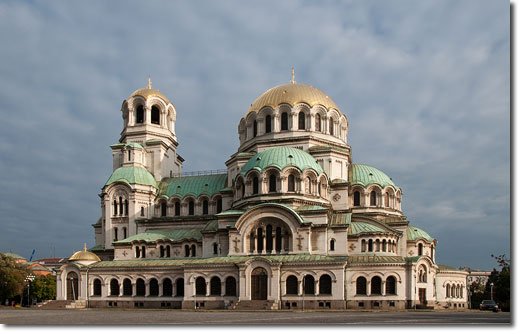
St. Alexander Nevsky Cathedral in Sofia, Bulgaria. It serves as the cathedral church of the Patriarch of Bulgaria and is one of the largest Eastern Orthodox cathedrals in the world. The foundation stone was laid on 3 March 1882.
Those proposing the modernistic ideals claim modern architecture and city planning is the peak of human achievement, freeing ourselves from outdated conventions and extravagancy. Sorry guys, nature is not outdated, but you are!
We can classify all architectural styles into two groups: natural and modernist. This classification is based on whether they follow or oppose the three laws of structural order and has nothing to do with the age of the buildings. Many people have always instinctively separated modernist from traditional buildings, but, without a set of written rules, there was never a systematic way of doing this. It is even possible to judge a “mixed” style by seeing which laws and sublaws it follows, and which it deliberately contradicts.
The architectural community distinguishes architectural styles according to the use of traditional materials such as stone and brick versus modern materials such as steel, glass, and light-weight reinforced concrete. Our results show this distinction not to be very relevant, since constructions that contradict the three laws are possible using any materials. On the other hand, some of the most beautiful Art Nouveau buildings, which follow our laws, were made possible by modern materials. – The Laws of Architecture from a Physicist’s Perspective, by Nikos A. Salingaros
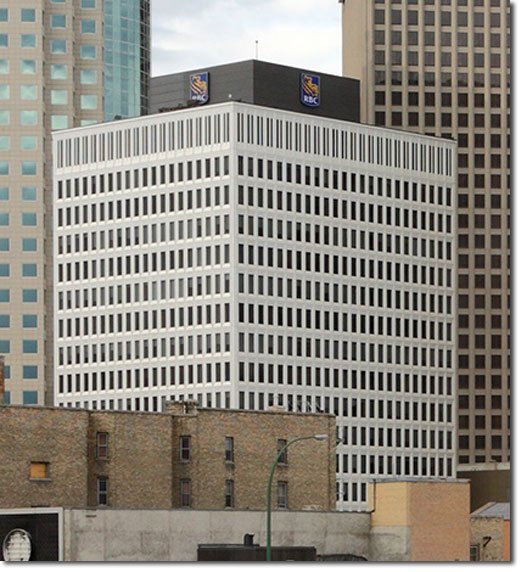
Where is the natural geometry?
No matter how much the Norwegian Opera wants to imitate a glacier, no matter how much it is covered with the finest natural marble, as long as it opposes the three laws of structural order it is not natural. And hence it cannot create real life like the real glacier did inside my wife and me.
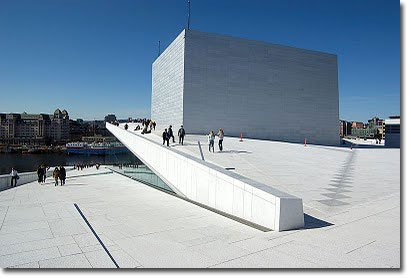
The Norwegian Opera
What is worse is that modernistic structures just don’t oppress life, they also destroy life:
This is, of course, a rampant nod to commercialism, which, if we did not live in such a commercial era, would be seen for what it is. The life of a community cannot be held hostage, by a person or corporation who seeks to make money and profit from the construction of its streets and buildings. The streets and buildings are part of the neighborhood’s life blood, the city’s life blood, and they must be interwoven with the activities and life of the people themselves. Anything less leads inevitably to drug abuse, crime, teenage violence, anomie, and despair – the very earmarks of modern urbanism. - Christopher Alexander
The high rate of crime among teenagers is not because they are worse people than previous generations. The reason is that we have given them a worse environment!
You just can’t change the kids; you have to change the context these kids are a part of. – Laurence Steinberg

This can only happen through integrated design
When the needs of people cannot be met from within the design, we pay the price in loneliness and crime. - Øyvind Holmstad
Another consequence of zoning laws and separation of function and people is loneliness, a modern disease that might even match obesity in spread. Some entrepreneurs would try to convince you that loneliness is your fault, so that they can sell you books, courses and products to help make you popular. But loneliness is not just a product of personality; it is a product of design, or the lack of integrated design.
"I understand that in some ways it is easier to live alone," Phil says. "You go back to your groovy apartment in Docklands, but you also face the greatest disease of western society which is loneliness." –Phil Bourne

A lonely man living at Isolation Street
Unfortunately I regularly learn about new eco-monstrous building projects based upon the segregation ideal and skyscrapers, like this grim Chinese example. There is abundant evidence to show that high buildings make people crazy. Apartment buildings taller than four stores are just as inhuman as suburbia!
The global industrial system has learned the appeal of sustainability, and it is applying clever and deceptive techniques in order to perpetuate its world business. Perhaps the greatest threat faced by human-scale urbanism today lies in the nightmarish “sustainable” cities and urban projects proposed and built by fashionable architects. The global system has picked up the sustainable vocabulary and has used it to re-package their extraordinarily expensive and fundamentally unsustainable products (glass and steel towers, monstrous buildings, industrial-style cities in the middle of nowhere) as “sustainable”. The trick consists of using some technological gimmicks, and coming up with numbers for energy saved through having some solar panels and double glazing on the buildings’ glass façades. But this is a fundamental deception, since the city or country that buys one of these eco-monsters becomes totally dependent on the consumerist energy system. – Life and the Geometry of the Environment, by Nikos A. Salingaros
Kyle Chamberlain ran a series at the PRI Blog called Respecting Ourselves. Modernistic ideology doesn’t respect us as humans as it fails to acknowledge that humanity is part of nature, by rejecting any attempt to imitate natural geometry and patterns, and by replacing our tribal patterns with a machinelike structure of life. That we have now spent half the world’s oil creating a society based upon modernism and social atomism is a disaster!
Rem Koolhaas sees this as the crisis of modernity. He says that “Modernism’s alchemistic promise – to transform quantity into quality through abstraction and repetition – has been a failure, a hoax: magic that didn’t work.” In his apt metaphor, we stand at the bottom of a “crater of modernity.” The architecture we produce, then, is little more than re-assembled bits from the blast. – Katarxis Nº 3
You cannot imitate nature through abstraction, repetition and fancy ideas! The Norwegian Opera was an abstraction of a glacier; others have abstracted a fish or a tree. Qatar is going to build a skyscraper that looks like a cactus. Or what about houses looking like eggs? The problem is that people are not chickens. In Southern Sudan I heard some got the stupid idea to make cities shaped like animals when seen from the sky. Some want to build a city looking like a star. The postmodernists and the starchitects have an addiction to arbitrary forms, paying no respect at all for the larger whole. This is in stark contrast to the strong Taoist worldview held by Christopher Alexander.
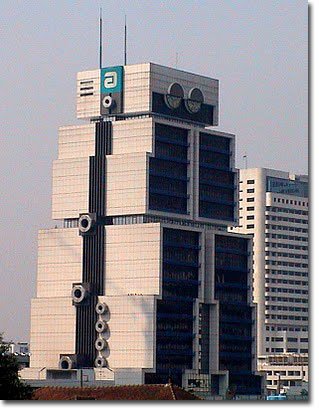
A robot building
Modernists do not make architecture to serve humanity, but to serve themselves. What they say is: Look at me, look at me, this is so unique and I’m very special. We see here the worst side of the handicap principle, the self-centered side. These buildings express nothing but pure ego.
The starchitects get the media attention, because their buildings are designed to call attention to themselves, but they are not important thinkers. – Charles Siegel
We have here a third dogma of modernism, the image. Human architecture is never just an image! Natural architecture is founded upon the three laws of structural order and the fifteen properties of life (those which appear in nature through morphogenesis), and it is generated like nature is. It is, moreover, part of a meaningful and interconnected pattern language (network), and pays great attention to the larger whole of the place. Wholeness is the ultimate goal! Why ancient villages, towns and cities were so beautiful, merging into the landscape, was because they were image-free, which means they were ego free. They were a gift to God!
In early times the city itself was intended as an image of the universe – its form guarantee of the connection between the heavens and the earth, a picture of a whole and coherent way of life. – The Timeless Way of Building, by Christopher Alexander
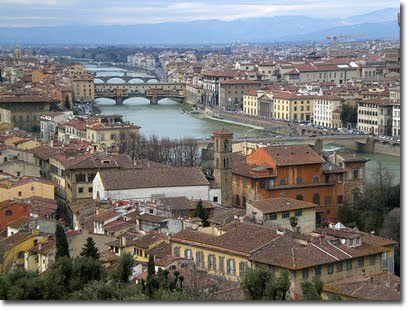
Florence, Italy
Polyzoides believes that architecture should not just be about who can design the fanciest or wildest-looking building. If human beings have the obligation to leave the world a better place than they found it, designing the buildings and communities in which we live can play a huge part. “Architecture is not an aloof and isolated subject,” he said. “It belongs to a very time-honored human enterprise of building cities and coming to grips with nature. If you see architecture that way, it is never isolated. It is never insulated. It is never a subject by itself.” – Stefanos Polyzoides
True, architecture is not an aloof and isolated subject; it is a part of the wholeness of place and buildings. Unfortunately Norwegian bureaucrats and architects have for some decades now had the idea of contrasting “old” and “modern”. The result is that almost all the beautiful wooden hotels of Fjord Norway from late 19th and early 20th century are destroyed through exceptionally ugly modernistic extension work — watching it is like getting glass splinters in your eyes. This destruction of historic beauty makes me cry!
How can we get out from this dark crater of modernity that we have made for ourselves? I want to give you a wonderful quote from Charles Siegel:
When we stop thinking about cities as bundles of technical problems and start thinking about cities qualitatively, about the different ways we live in different types of cities, then we will be able to act as citizens who use the law to govern ourselves – not as clients who expect the planners to provide us with more housing, more transportation, and a better environment. – Unplanning – Livable Cities and Political Choices, by Charles Siegel
We find here a fourth dogma of modernism, that city planning and the way we live our lives are technical problems to be solved by experts. Unfortunately this attitude makes us all merely clients, and we stop being experts of living. Craig Mackintosh explains this tragedy perfectly in his very readable essay titled “Developed?” The time is now well overdue for taking back our right to choose our own way of life. If you still have doubts, please read Charles Siegel’s book here, it is free to read. Don’t leave this most important matter of your life to the elites!
According to Berry, “the corruption of community has its source in the corruption of character.” And this corruption of character is the result of the inability or unwillingness to understand the complex and often messy whole. It follows, then, that “the disease of the modern character is specialization.” Specialization fragments tasks, fragments competencies, fragments individual character, and ultimately fragments the idea of community. - Wendell Berry and the New Urbanism: Agrarian Remedies, Urban Prospects

Sterile housing-block-suburbia made by “experts”
While modernistic thinking has a simplistic, mechanistic and machinelike perspective on the world, rooted in Descartes’ idea of isolating the parts you want to examine, permaculture has a much more complex and organic understanding of the world.
Take for example the permaculture movement. Permaculture is revolutionizing our relation with the biological environment, because nature is not any more considered an object of human labor and control, but rather as a self-organizing system in a way very similar to design patterns: doing almost all of the work and maintaining itself, if arranged properly. It is probably no incident that this special view of nature has emerged simultaneously with the use of cybernetics and modern information theory. In a way the permaculture view on nature is similar to a programmer’s view that creates interacting objects that are capable of fulfilling autonomous tasks in interaction with each other. The simple notion is that nature is by far too complex for humans to manage the system themselves, so we look for a system of checks and balances that works, and we find thousands of natural systems and organisms that already have a highly interactive and synergetic potential, they are fine-tuned to permanently react on time and produce what’s needed to keep the system alive. – Franz Nahrada
I hope it now stands clear for readers that permaculture cannot be united with a modernistic world view and the design derived from this. Permaculture design is the opposite of modernistic design in every aspect, and represents a new era for humanity. In Part I of Kyle Chamberlain’s series he describes the term EEA:
We can infer then, despite the many deprivations humans suffer today, at some time in the past, our species occupied an environment which offered us everything we needed. Actually, scientists have a word for such an environment: it is called the ‘environment of evolutionary adaptedness’ or EEA. All creatures have an EEA, an optimum habitat, and will not thrive if removed from it. Some creatures are so enmeshed with their environment that they cannot perform even basic life functions if removed. Such is the case of pandas and cheetahs, which are known to struggle just to reproduce in captivity. Conservationists know that the best way to ensure the well being of any species is to protect it within the context of its habitat. – Kyle Chamberlain
The dogmas of modernism, and I’ve just revealed four of them here, are at their very core inhumane. To live in an optimum human habitat, or EEA, should be a fundamental human right!
The built environment, with its geometrical symbolism, talks about the culture that has created it, and expresses the intimate values of a culture. So, if in the past the built environment was interconnected with their physical and spiritual surroundings, the contemporary has expressed the excessive power of a mechanical culture determining the loss of human identity in favor of “artificial identity”. This artificial structure has transferred its cultural reductionism also to urbanism and architecture and caused laceration of society and deformation of ethical and esthetical values. This new design represents and symbolizes new values like hedonism and a devoid sense of nothing, and is the sculptural expression of our society. –International Society of Biourbanism
Modernism means nothing because it expresses nothing but emptiness and absence of nature and real human life. Permaculture design is in contrast always searching for an optimization of the EEA, and not just for humans but for all creatures. Still, what is optimum for maximum biodiversity of life is also the optimum human EEA. Permaculture is simply the expertise of living, or maybe we rather should say the expertise of maximizing life — in all forms!
You must be logged in to comment.

| Permaculture Design Course |
| Type: Permaculture Design Certificate (PDC) course |
| Teacher: Aranya Austin |
| Location: Orreviks Gård, Sweden |
| Date: Jul 2011 |